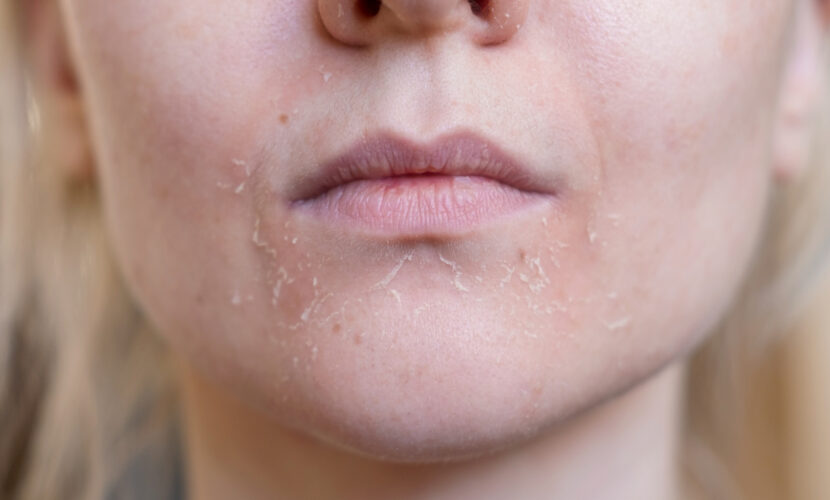Velvet Skin is a beauty treatment that combines a dermapen and massage peel, and is popular for improving skin elasticity and luster. However, many people may experience "peeling" after the procedure and may feel uneasy.
Although peeling can be a sign of the effects of the procedure, it can also lead to skin problems if proper skin care is not taken. Here, we thoroughly explain the causes and duration of peeling after Velvet Skin, as well as the proper skincare regimen. We will also detail the key points to minimize downtime after the procedure and achieve more beautiful skin.

Graduated from the Faculty of Medicine, National Kumamoto University. After serving as the director of major beauty clinics in Japan, etc., he opened Aladdin Aesthetic Clinic in 2023. He is a professional in aesthetic medicine with a doctorate in anti-aging research and many years of experience. With the motto of "Toward the realization of cosmetic medicine without lies," he aims to be the "Only One" together with his patients.
What is Velvet Skin? Effects and Treatment Features
With the evolution of cosmetic medicine, there has been a growing demand for procedures that are more effective and require less downtime. Among these, "Velvet Skin" is a beauty treatment that combines a dermapen and massage peel, and is favored by many people.
This is a particularly attractive procedure for those seeking skin elasticity and luminosity, and for those with acne scars and pore problems. However, a proper understanding of the "peeling" and downtime that occurs after the procedure and appropriate care is the key to maximizing results.
Velvet Skin Basic Information
Velvet Skin is a procedure that is a cross between a "dermapen" and a "massage peel". The features of each are briefly described below,
- Dermapen: Uses an ultra-fine needle to make microscopic holes on the skin surface to promote collagen and elastin production and skin regeneration. Effective in improving acne scars, pore size, and uneven skin tone.
- Massage peel: A special agent containing TCA (trichloroacetic acid) and kojic acid is applied to promote skin turnover. Skin elasticity and firmness are improved, and a whitening effect can be expected.
By combining these two treatments, Velvet Skin provides a rebirth-like effect from deep within the skin. It is particularly suitable for those who are concerned about skin deterioration due to aging and those who are looking for a beauty treatment to improve skin texture.
In addition, the massage peel effectively complements the microscopic scarring caused by the dermapen, making it easier to feel the firmness and luster after the treatment than with the regular dermapen alone.
Advantages of Velvet Skin
Velvet Skin is a treatment that improves skin texture at a deeper level than can be achieved with mere skin care. By exfoliating dead skin cells and promoting the production of new skin cells, it leads to clear, dull skin. This treatment is especially recommended for those who are concerned about blemishes and dullness caused by UV damage.
In cosmetic medicine, "downtime" such as redness and peeling after a procedure is unavoidable. However, Velvet Skin is one of the milder peels, and in many cases, the skin settles within a few days. It is an easy procedure for those who are too busy to take long periods of downtime.
In general, skin care and cosmetic treatments require a certain period of time before the effects can be felt, but Velvet Skin is characterized by the fact that the skin's firmness and luster can be felt immediately after the treatment. In particular, the change in the feel and luster of the skin is easily noticeable, making it suitable for those seeking immediate results.
Downtime for Velvet Skin
Even though Velvet Skin has a relatively short downtime, it is important to understand that certain reactions will occur after the procedure.
| symptoms | Timing of Appearance | Continuation Period |
|---|---|---|
| blush | Immediately after treatment - 1st day | Approx. 2 to 3 days |
| peeling off | Second to third day of treatment | Approx. 1 week |
| dryness | Immediately after treatment - 3rd day | 5 days to 1 week |
Due to the microscopic scarring caused by the dermapen, redness is most likely to occur immediately after the procedure. The redness usually subsides within a few days, but may last up to a week for those with sensitive skin.
In peeling, the action of PRX-T33 (massage peel) causes the skin to exfoliate. Peeling usually begins 2 to 3 days after the procedure and usually settles down after about a week.
After the procedure, the skin is more prone to dryness because the barrier function is temporarily impaired, making it difficult to retain moisture. Therefore, it is extremely important to take thorough care to retain moisture after the procedure. In particular, hypoallergenic moisturizers containing ceramide and hyaluronic acid should be used to prevent dryness.
Why does peeling occur after velvet skin?
Velvet Skin is a popular procedure that maximizes the skin's regenerative power. In the previous issue, we described the features of the procedure that combines the Dermapen and PRX-T33 (massage peel). Many people may be concerned about the "peeling" that many people experience after Velvet Skin.
This peeling is not a bad reaction; rather, it is evidence that the skin is about to be reborn. As mentioned a little earlier, why does peeling occur? How long does it last? Here, we will explain the mechanism and how to deal with it in detail.
Causes of peeling after velvet skin treatment!
Three mechanisms are involved in post-velvet skin peeling.
(1) Acceleration of "micro-scarring" and turnover with dermapen
Dermapen is a procedure that uses an ultra-fine needle to puncture the skin with more than 1,000 microscopic holes per second. This stimulation puts the skin into "self-repair mode" and accelerates its efforts to create new skin.
Normally, the skin turnover (cell renewal) cycle is approximately 28 days, but after the Dermapen treatment, this cycle is temporarily shortened and the speed at which dead skin cells are exfoliated is accelerated.
(2) Exfoliating action of PRX-T33 (massage peel)
The PRX-T33 used in the Velvet Skin procedure contains the following ingredients
| component | Main action |
|---|---|
| TCA (trichloroacetic acid) | Promotes skin turnover and exfoliates dead skin cells |
| kojic acid | Suppresses melanin production, resulting in a whitening effect |
(3) Natural exfoliation through accelerated skin turnover
The synergistic effect of the dermapen and massage peel causes the skin to turnover at a faster pace than usual, resulting in peeling. In particular, dry skin, which tends to have a delayed turnover, tends to show more peeling.
Duration and degree of peeling
The duration and degree of peeling varies from person to person, but the general process is as follows.
| Peeling condition | Occurrence timing | recovery period | feature |
|---|---|---|---|
| Mild peeling | 2-3 days after treatment | Approx. 1 week | coming off partially in a thin layer |
| moderate peeling | 2-3 days after treatment | Approx. 1 week | Thinly peeling skin over the entire face |
| severe peeling | 2-3 days after treatment | About 10 days | More noticeable as dryness progresses. |
After a Velvet Skin treatment, peeling often begins around the first to third day. At this point, the peeling is still only a thin layer, and for some it is not noticeable.
Subsequently, peeling begins in earnest from 2 to 5 days after the procedure. People who are particularly prone to dryness or who have active skin turnover may experience visible skin peeling. It is important to never peel the skin by hand and wait for it to peel off naturally, as forcing the skin to peel off during this period can damage the skin and increase the risk of inflammation and pigmentation.
In most cases, the peeling generally settles down after a week or so, but in cases of severe dryness, the peeling may persist for a longer period of time. Therefore, it is important to keep the skin well moisturized after the treatment.
Key points to minimize peeling of velvet skin!
Although peeling after Velvet Skin is a natural part of the process of showing the effects of the procedure, proper skin care can reduce the degree of peeling and minimize the stress on the skin.
In addition to post-treatment care, it is also very important to maintain the skin's barrier function before the procedure to reduce downtime. Here we will discuss in detail the key points to minimize peeling and promote a smoother recovery.
| Anti-peeling | Specific Methods |
|---|---|
| Thoroughly moisturize | Use moisturizers containing ceramide, hyaluronic acid, and glycerin / Avoid cosmetics containing alcohol and fragrance |
| Thoroughly protect against ultraviolet rays | Use sunscreen with SPF50+ and PA++++ / Protect skin with hat and parasol |
| Don't force the skin. | Wait for the skin to peel off naturally even if peeling is bothersome / Forced peeling may cause hyperpigmentation and inflammation |
| Avoid harsh skin care | Retinol, vitamin C, and peeling ingredients are resumed after the peeling has settled. |
Skin care before treatment prepares the skin!
Optimal skin preparation prior to a Velvet Skin procedure can help reduce peeling and redness after the procedure. Skin care prior to the procedure will also affect the results after the procedure, so you need to be aware of a few things to prepare your skin.
The first step is to improve the skin barrier function. If the skin barrier function is impaired, the skin will be less resistant to irritation after the procedure and may peel more strongly. Therefore, it is important to moisturize the skin well one week prior to the procedure to improve the skin's ability to retain moisture.
- Ceramide: Strengthens the barrier function of the stratum corneum and protects the skin from external stimuli
- Hyaluronic acid: Holds moisture well and keeps skin moist
- Amino acids: support skin's ability to retain moisture and prevent dryness
In addition, the use of strong peels or skin care products containing retinol or vitamin C should be avoided prior to the Velvet Skin procedure. These ingredients can accelerate turnover, which may result in more intense peeling after the procedure.
Gentle skin care during the week prior to the procedure can reduce downtime after the procedure.
Post-treatment skin care tips
Post-velvet skin has a temporarily reduced barrier function and is more susceptible to external stimuli. It is especially important to carefully care for the skin during the first week after the procedure. Since the skin after the procedure tends to have less ability to retain moisture, proper moisturizing will prevent dryness and reduce peeling.
- Choose a lotion that is hypoallergenic (no alcohol or fragrance added)
- Use moisturizers containing ceramide or hyaluronic acid
- Oil or Vaseline to prevent moisture evaporation (but sparingly if pores are easily clogged)
The skin during peeling after the procedure is more susceptible to ultraviolet rays, which can cause hyperpigmentation. Therefore, it is essential to use sunscreen and physical UV protection.
Also, when peeling occurs, it is easy to become concerned and forcibly peel off the skin, but this is an act that should be avoided at all costs. Forced peeling damages the still immature new skin and increases the risk of inflammation and hyperpigmentation, so wait for the skin to peel off naturally.
Skin during peeling is more sensitive, and skin care products containing retinol, vitamin C, and peeling ingredients are very good for beauty to promote turnover, but should be avoided for a period of time. These ingredients can be highly irritating to the skin and cause redness and burning.
Points to discuss at the clinic
If you are considering a Velvet Skin procedure or are concerned about peeling after the procedure, we recommend that you consult with the clinic beforehand. The degree to which peeling occurs after the procedure depends on the skin type and the intensity of the procedure. By consulting with a doctor in advance and deciding on a treatment plan that suits your skin, you can avoid excessive downtime.
Below are points to be confirmed during the consultation.
- Can the intensity of the treatment (power output and concentration of drugs used) be adjusted?
- If you have had skin problems in the past, can you undergo the procedure?
- Ask for details about the duration of downtime and the possibility of skin peeling.
- (2) Receive specific guidance on aftercare after the procedure.
Improper post-treatment care can lead to prolonged peeling and increased risk of hyperpigmentation. It is important to make sure that the clinic provides detailed guidance on skin care and precautions to be taken after the procedure.
Balancing the effects and downtime of Velvet Skin
Velvet Skin is a cosmetic procedure that combines a dermapen and PRX-T33 (massage peel) to promote skin turnover and improve firmness and luster. However, in order to maximize the effects of the procedure, it is important to understand the balance between downtime and proper care.
In the previous issue, we explained how to minimize peeling. To begin with, peeling is a sign that the effects of the procedure are well underway, and proper care can achieve higher cosmetic results.
In addition to peeling, side effects such as redness, burning, heat, rash, internal bleeding, and swelling may occur, and it is important to understand these risks. This chapter will explain in detail the relationship between the "effects" and "downtime" of Velvet Skin.
Peeling is a sign that the treatment is effective.
Our skin has a turnover cycle that renews itself into new cells in approximately 28-day cycles. However, when this cycle is disrupted by aging, UV damage, or dryness, dead skin cells accumulate on the skin, causing dullness, roughness, and clogged pores.
Velvet Skin promotes skin regeneration at a faster-than-normal pace through the stimulation provided by the fine needles of the dermapen and the exfoliating action of PRX-T33. During this process, old keratin is exfoliated away and new skin is brought to the surface, resulting in "peeling.
However, if the subsequent skin care is not appropriate, the effects of VELVET SKIN cannot be fully utilized. Proper care will bring out the full effect of VELVET SKIN and achieve a more beautiful finish.
Side effects and risks other than peeling
Velvet Skin is a relatively short downtime procedure, but there are several side effects that may occur in addition to peeling. It is important to understand in advance what risks are involved and be prepared to deal with them appropriately.
| Side Effects/Risks | Possibility of Occurrence | Main Causes | Countermeasures and remedies |
|---|---|---|---|
| blush | Immediately after treatment - several days | Irritation due to microscopic scratches from dermapen | Cooling and moisturizing to reduce irritation |
| stinging | Immediately after treatment - several days | Temporary irritation due to exfoliating action | Use hypoallergenic skin care and avoid excessive friction |
| Heat, swelling | Immediately after treatment - 2 days | Skin inflammatory reaction | Cooling is performed, and if symptoms are severe, consult a physician. |
| Rash, internal bleeding | Immediately after treatment - several days | Stimulation during treatment | Mild cases will disappear spontaneously, but if they worsen, see a doctor. |
| itch | When the skin begins to peel | Reaction due to dryness and accelerated turnover | Thoroughly moisturize and do not forcefully rub. |
| pigmentation | 1 week to several months after treatment | UV damage, excessive friction and inflammation | Use SPF 50+ sunscreen and do not rub skin |
| allergic reaction | Immediately after treatment - several days | Hypersensitivity reactions to drugs used in the treatment | Undergo a patch test beforehand, consult a doctor immediately if there is any abnormality |
The skin after the procedure is extremely delicate and may experience redness and burning. There is no need to be overly concerned, as the redness usually settles down within a few days. However, if the redness persists for more than a week, it is recommended to consult the clinic where the procedure was performed.
Post-treatment skin is more susceptible to UV damage, and exposure to UV rays risks causing hyperpigmentation, so it is important to apply sunscreen and take thorough measures to protect the skin from UV rays.
summary
Velvet Skin is a popular cosmetic procedure that improves skin quality through the synergistic effects of dermapen and massage peels. Although peeling after the procedure occurs during the process of accelerated skin turnover, proper skin care can shorten the downtime.
It is important to keep the skin thoroughly moisturized, UV-protected and hypoallergenic. In addition, consulting with the clinic in advance and taking care of your skin according to your own skin needs will help you achieve higher cosmetic results. Take good care of your skin before and after the treatment to obtain your ideal beautiful skin.
At Aladdin Aesthetic Clinic, based on our many years of experience in cosmetic medicine and cosmetic dermatology and the knowledge of our doctoral degree, we provide counseling that aims to be "only one", offering the best treatment for each person we meet. We offer only the necessary treatments without any unnecessary information or suggestions.
Feel free to use our official LINE account for 24-hour counseling and reservations. Please feel free to contact us for free counseling for the first time or if you have any concerns.






